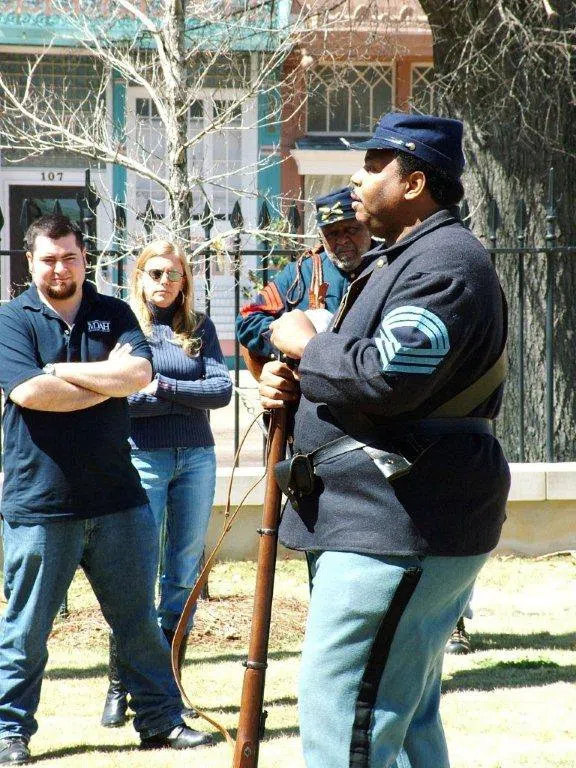NATCHEZ, Miss. — The summer of 1863 in Natchez was anything but an ordinary summer, according to Ser Seshsh Ab Heter-C. M. Boxley. Among other things, he said, it was a summer of freedom from 144 years of chattel enslavement from 1719 to 1863.
On July 13, 1863, thousands of enslaved people became self-emancipated when they fled plantations — and other places of bondage — when the Union Army took over Natchez and Vidalia, he said.
“I call this day, ‘Julyteenth,’” Ser Boxley said. “It was on this day that the Union Army offloaded at Natchez Under the Hill, and the U. S. 11th Illinois Regiment Infantry marched up Silver Street and began the occupation of Natchez. This is when those who were enslaved in the old Natchez district obtained their Emancipation Proclamation freedom behind Union Army lines.
In commemoration of this day, the 161st Julyteenth Anniversary will be observed on Saturday, July 13, from 7 to 9 a.m. The free event is organized by Ser Boxley, who is coordinator of Friends of the Forks of the Roads Society.
The program will include a caravan that will travel to several historical sites where re-enactors will share the history of the freedom event that occurred in Natchez in July 1863. The theme for the program is, “From Julyteenth Freedom Summer of 1863 in Natchez, Mississippi, to Juneteenth Freedom Summer of 1865 in Galveston, Texas.”
“This event is important,” said Ser Boxley. “During Freedom Summer of 1863, our ancestors ran away to become freedom fighters. They joined the U.S. Colored Troops and fought for freedom. They became Union Army freedom fighting soldiers and sailors.”
Strictly speaking, the “Union Army’s occupation of Natchez turned the city into a freedom city destination,” Ser Boxley said.
Unfortunately, he said, about 400 enslaved people in Natchez were shipped out to Texas on July 1, 1863, and were prevented from gaining their freedom. Many did not gain their freedom until they returned to Natchez in 1866, he said.
Saturday’s commemoration will start at the Forks of the Road and end at Watkins Street Cemetery. It is organized as follows:
1. Forks of the Road
The program will begin with a solemn assembly at Forks of the Road, which is a fitting location, said Ser Boxley. “You have slavery and freedom at this site. Burl Lewis and several others fled from Browns Sawmill and ran to the Forks, where they found freedom. There was an enrollment and recruitment station at the Forks. We will tell that story and leave a wreath.”
2. Broadway and Silver Street
The caravan will travel to Broadway and Silver streets where the Union Army arrived by boat. The landing and disbarment occurred July 13, 1863.
3. Under the Hill near Magnolia Vale
The caravan will travel to Magnolia Vale by way of Learned Hill. This is the site of the U.S. Colored Troops and contraband camp near the Devil’s Punch Bowl.
4. Natchez National Cemetery
Attendees will be invited to visit the graves of Edward Turner, a member of the U.S. 3rd U.S. Colored Cavalry, in Section G; and Cary Blanchard, a member of the 70th U.S. Colored Infantry in Section A.
5. Watkins Street Cemetery
The story of Fredrick Caldwell will be told at Watkins Street Cemetery. Caldwell was member of the 51st U.S. Colored Infantry. Ser Boxley said that Sgt. Maj. Norman Fisher of 1st U. S. Mississippi Colored Infantry Re-enactors will tell the story of his great-grandfather of the 51st USCT who fought at Milliken’s Bend, La., Fort Blakey, Ala. “He was sent out to Texas with thousands of Union troops to force Texas Confederate Army to Surrender,” Ser Boxley said. “This is how Juneteenth happened.” The program will end with a black-powder gun salute.
For more information, call Ser Boxley at 601-334-6488.





This is a great article. The African American experience in the U.S. and K-12 will most likely never reach this level in history books. I get excited about these events, wish we had more of them to let people know our true history.